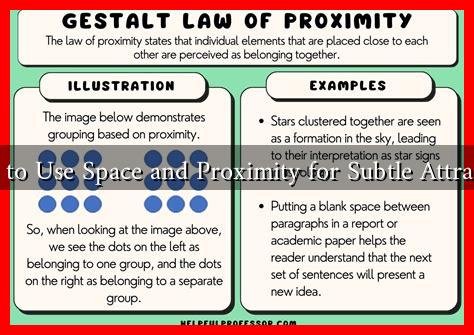-
Table of Contents
How to Use Space and Proximity for Subtle Attraction
Attraction is a complex interplay of psychological, emotional, and physical factors. One of the most intriguing aspects of attraction is how space and proximity can influence our feelings towards others. Understanding how to effectively use these elements can enhance your social interactions and foster deeper connections. This article explores the nuances of space and proximity in the context of attraction, providing practical tips and insights.
The Psychology of Proximity
Proximity plays a crucial role in human relationships. The mere exposure effect, a psychological phenomenon, suggests that people tend to develop a preference for things merely because they are familiar with them. This principle can be applied to attraction in several ways:
- Familiarity Breeds Attraction: The more we see someone, the more we may like them. This is why social settings, such as schools or workplaces, often lead to romantic relationships.
- Shared Experiences: Engaging in activities together can create bonds. Whether it’s a group project or a shared hobby, these experiences can enhance feelings of attraction.
- Social Proof: Being around others who are attracted to someone can increase your own attraction. This is often seen in social gatherings where a person is the center of attention.
Understanding Personal Space
Personal space is the physical distance we maintain from others, which varies based on cultural norms and individual preferences. Understanding and respecting personal space is essential for fostering attraction without making others uncomfortable.
- Intimate Distance (0-18 inches): This space is reserved for close relationships, such as romantic partners. Invading this space can create intimacy but should be approached with caution.
- Personal Distance (1.5-4 feet): This is the ideal distance for friends and acquaintances. It allows for comfortable conversation while maintaining a sense of personal space.
- Social Distance (4-12 feet): This distance is appropriate for formal interactions, such as in professional settings. It helps maintain a level of professionalism while still being approachable.
Using Space to Create Attraction
Here are some strategies to effectively use space and proximity to enhance attraction:
- Positioning: When in a group, position yourself near the person you are interested in. This subtle move can create opportunities for interaction.
- Mirroring Body Language: Subtly mimicking the other person’s posture or gestures can create a sense of connection and rapport.
- Engaging in Shared Activities: Participate in activities that require close proximity, such as dancing or team sports, to foster a sense of closeness.
- Utilizing Eye Contact: Maintaining eye contact while speaking can create a sense of intimacy and connection, making the other person feel valued.
Case Studies and Statistics
Research supports the idea that proximity can significantly impact attraction. A study published in the journal Personality and Social Psychology Bulletin found that individuals who frequently interacted with each other were more likely to develop romantic feelings over time. Additionally, a survey conducted by the Pew Research Center revealed that 30% of adults reported meeting their partners through mutual friends, highlighting the importance of social proximity.
Conclusion
Understanding how to use space and proximity effectively can significantly enhance your ability to attract others. By being mindful of personal space, engaging in shared experiences, and utilizing body language, you can create an environment conducive to attraction. Remember, the key is to balance closeness with respect for personal boundaries. As you navigate social interactions, keep these principles in mind to foster deeper connections and potentially ignite romantic sparks.

